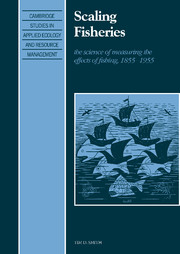Part II - DEVELOPING METHODS, 1855–1940
Published online by Cambridge University Press: 22 September 2009
Summary
Between 1855 and 1940 the key methods and approaches were developed for the study of the causes of fluctuations in fisheries and the closely related problem of the effects of exploitation on marine animals. In Part II, I describe this development using selected examples of how the different scientific methods were first or best developed, and how the fishery itself illustrates particularly important points about the biological, economic, social, and political milieu in which the study of fish population dynamics has developed.
In chapter 2, I describe several of the scientific programs developed before 1890, some of which were touched on in chapter 1, focusing on the motivations for their creation and the goals of the work. Although Sweden had supported several biologists to study its herring fishery starting in the 1830s (Sinclair and Solemdal 1988), the earliest organized scientific investigation of marine fisheries appears to have been in Russia from 1853 into the 1860s. After initially concentrating on fresh water lakes, Karl Ber and Nikolai Danilevskii in the later years of their study expanded it south to the Black Sea and north to the Barents Sea (Borisov, 1960 pp. 17–20). In chapter 2, I consider three of the scientific programs that evolved subsequently and the agencies that developed them: the United States Fish Commission, which was started in 1871, the Fishery Board for Scotland, which was reorganized in the 1880s, and the Marine Biological Association, which opened its laboratory in Plymouth, England, in the late 1880s.
- Type
- Chapter
- Information
- Scaling FisheriesThe Science of Measuring the Effects of Fishing, 1855–1955, pp. 35 - 37Publisher: Cambridge University PressPrint publication year: 1994



